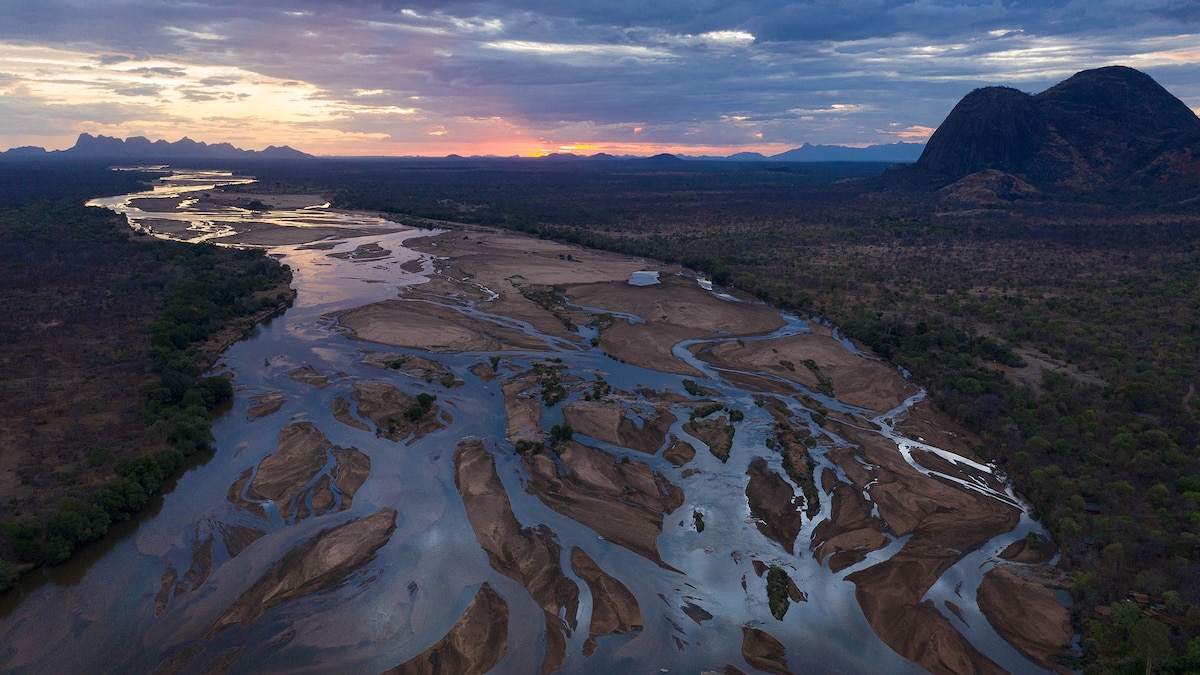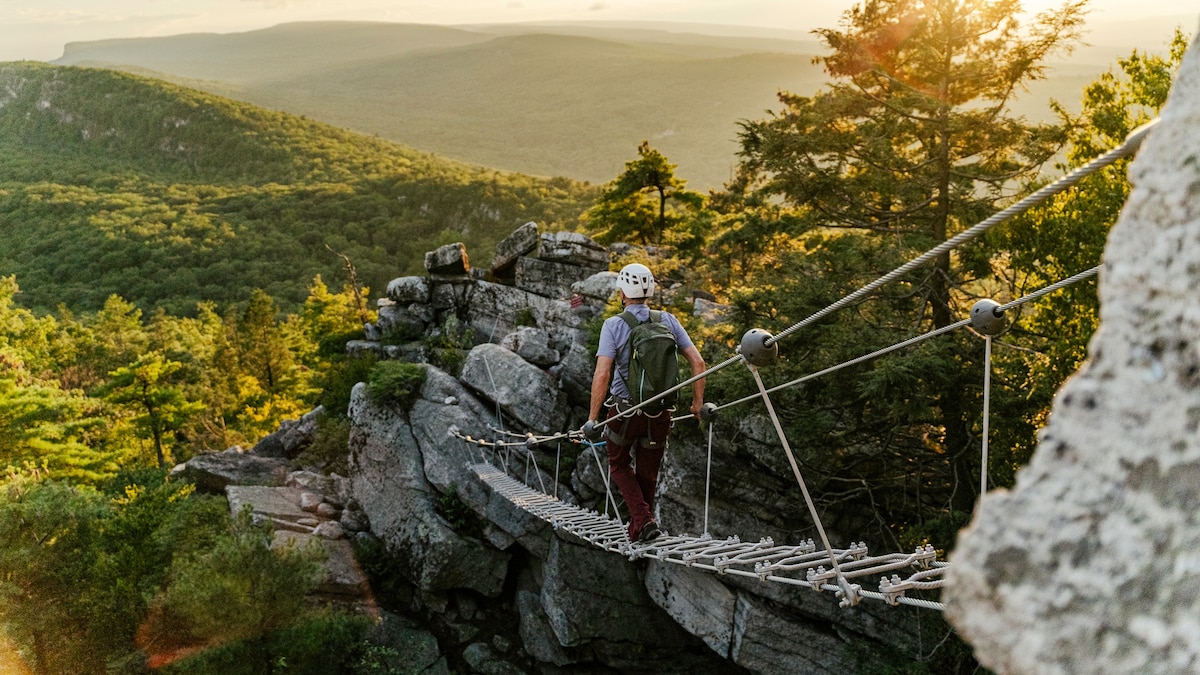Now Reading: Mozambique’s Niassa reserve was a conservation paradise. Then ISIS attacked.
-
01
Mozambique’s Niassa reserve was a conservation paradise. Then ISIS attacked.
Mozambique’s Niassa reserve was a conservation paradise. Then ISIS attacked.

ByScott Johnson
Photographs byThomas Peschak
Just after 7 p.m. on the evening of April 29, conservation ecologist Colleen Begg was having dinner with her husband, Keith, and their two teenage children when her phone beeped with a WhatsApp message: The Mariri Environmental Centre she had founded in Mozambique’s Niassa Special Reserve had been attacked by terrorists. Two thousand people from a nearby village had fled into the bush. Begg spent a sleepless night organizing rescue efforts, but by morning she confronted a grim reality. Five of the ranger scouts on her team were missing, and a conservation dream she and Keith had spent more than 20 years nurturing was on the brink of collapse.

The village of Mbamba, one of many within the reserve, was closest to the attack. Elsewhere in Africa, villages were often removed to make way for protected areas, but not in Niassa, where humans have lived alongside wildlife as part of the ecosystem for tens of thousands of years.

The reserve is one of the last refuges for the critically endangered African wild dog, with some 300 of them roaming Niassa’s plains. The dogs sleep for most of the day, grow active in the evening, and then hunt at night.

Before the April terrorist attacks, conservation efforts in Niassa were flourishing. The reserve’s lion population blossomed to between 800 and 1,000 animals, one of only seven populations of that size left in Africa. The reserve could hold twice that number, a unique prospect in a time of shrinking wild spaces.

At some 17,000 square miles, bigger than the country of Switzerland, Niassa is one of Africa’s largest and wildest protected spaces. This aerial view takes in the grandeur of its granite inselbergs, which rise like gray giants from the woodlands and plains of Niassa.
Today, more than a month after the attack, the situation in Niassa remains perilous. The death toll from multiple attacks has risen to at least 10, with more injured and missing. And with each day that passes, the threats to years of careful conservation work and vital economic growth become more acute.
Fully half of the Niassa reserve is now closed and under full military occupation as the Mozambican Army continues to patrol the park for Islamic State insurgents. The reserve’s economic and business models are crumbling as families flee for safer ground, and tourism operators scramble to do damage control. Along the Lugenda River, nine conservation and tourism camps and 22 scout posts now sit abandoned. The United Kingdom and the U.S. State Department have issued travel warnings for Mozambique. “The attack decimated the revenue structure from tourism,” says Begg, who runs the Niassa Carnivore Project. “Visitors won’t come.” Years of critical conservation work are at risk of coming undone.
Niassa was established as a hunting reserve in 1954 when Mozambique was still under Portuguese colonial control. It was transformed into a protected area in 1999, after years of civil war. More remote and less well known than the Ngorongoro Crater in Tanzania or Kruger National Park in South Africa, Niassa is unique for both its immense size and its approach to conservation. Unlike other reserves in Africa, where a so-called fortress conservation mentality—which prioritizes animal conservation at the expense of local communities—often prevails, the Niassa reserve has a thriving human population that has lived side by side with animals from earliest times.

At Chemambo, which is considered a sacred site in Niassa, people come from far and wide—including Tanzania, South Africa, Malawi, and across Mozambique—to receive blessings.

Many who come to Chemambo believe that yellow baboons house the spirits of their ancestors. Visitors give them offerings in the form of sugar, maize, corn, and peanuts.
Some 70,000 people are scattered across 47 villages in a fenceless expanse of more than 17,000 square miles of pristine wilderness. The reserve occupies an area larger than Switzerland, where humans coexist with the highest concentration of wildlife in Mozambique, including thriving populations of lions, elephants, hyenas, wild dogs, and honeybees. The 17 conservation and tourism concessions spread across the reserve run the gamut from budget eco-tourism to luxury safaris and sport hunting operations that bring in millions of dollars in revenue and employ tens of thousands of people.
“The attack was very emotional,” says Agostinho Jorge, the director of conservation for the Niassa Carnivore Project. “The most painful part was the suffering of the communities. It’s one of the poorest areas of Mozambique, and the last thing we would want is the area to get destabilized from these attacks.”

Before the attack, Mariri rangers loaded up the skulls of four dead elephants that were killed by poachers several years ago. The skulls were used in a memorial to remember the rampant poaching that once occurred in Niassa.

By day this water hole is used by women to wash clothes. By night elephants like this one can access it to quench their thirst, just one of many examples of how humans and wildlife have cooperated in Niassa. Before the April attack, elephant herds that had been decimated during a decade-long poaching crisis beginning in 2008 had begun to rebound.
Most people who live in Niassa are subsistence farmers and fishermen, and conservation is far and away the largest employer in the district. The attacks occurred just days before the year’s maize harvest, meaning locals were unable to reap the benefits of the year’s crop.
Over the years, local conservationists and authorities have developed a series of extensive regulations prohibiting poaching and the consumption of bushmeat, while also helping build alternative revenue streams and community tourism camps. “Now all of that is gone,” says Begg. A large part of the reserve’s annual million dollars in tourist revenue comes from trophy hunters, most of whom have now been forced to cancel upcoming trips. “I’m worried about the wildlife,” says Jorge. “If these areas aren’t protected, the numbers will start to drop if this situation goes on for too long.”
Before the attack, a wilderness success story
Before the April terrorist attacks, conservation measures in Niassa were flourishing. In recent years, the reserve’s lion population blossomed to between 800 and 1,000 animals, one of only seven populations of that size left in Africa. Elephant herds that had been decimated during a decade-long poaching crisis beginning in 2008 started to rebound. Some 350 African wild dogs roam Niassa’s plains, while honeyguide birds waft through forests looking for wax to eat and leading people to hidden honeybees’ nests, benefiting both species in a remarkable example of cooperation.

To reach these high branches of the baobab tree, honey hunter Luís Iwene free-soloes using wooden hammers and pegs to access his beehive. Smoke from the fire torch relaxes the bees and brings them out of the hive.
“In Niassa, people and wildlife not only coexist but collaborate,” says Claire Spottiswoode, an evolutionary ecologist leading a research project working in collaboration with the Mariri Environmental Centre and the nearby village of Mbamba for over a decade. “It’s one of the few remaining places where the unique cooperative partnership between people and honeyguide birds still thrives.”
(How locals have a stake in helping Niassa Special Reserve flourish)
ISIS in Mozambique
The latest attacks have their origin in an Islamic insurgency that began spreading across northern Mozambique in 2015. ISIS-M, as the group is known, has attempted to gain territory, add recruits, and spread fear through coordinated campaigns across the region. Its strength peaked around 2021 when the group’s fighters were estimated to number around 3,000. That year, insurgents struck Niassa for the first time, decapitating a Christian pastor in a local village and threatening conservation efforts. In response, forces from Rwanda and South Africa struck back, dramatically reducing the group’s strength and size.
But by mid-April of this year, militants were once again targeting several small villages just outside Niassa’s eastern border. “The insurgents have shown a lot of adaptability,” says Nicolas Delaunay, the International Crisis Group’s senior analyst for Mozambique. “We can see the contours of a multipronged strategy.” On April 19, they attacked the Kambako hunting lodge, across the Lugenda River from Mariri. They lingered there for four days, looting food, fuel, and supplies. Before leaving, they beheaded two local carpenters and burned the camp to the ground.

Carefully managed hunting tourism bolsters Niassa’s economy, along with income from safaris and conservation projects. Here, buffalo, sable, and other species are measured before being shipped to trophy hunters.
Within days, a contingent of 21 Mozambican Army soldiers were deployed to Begg’s camp as a protective measure. Begg cleared Mariri of its vehicles, computers, and aircraft, but left a small team of 12 anti-poaching scouts in place to prevent looting. It wasn’t enough, however, and on the 29th a group of well-armed, mask-wearing insurgents swarmed into Mariri and began shooting while crying, “Allahu Akbar.” On Begg’s instructions, the scouts scattered into the bush. Insurgents killed two scouts and six soldiers.
You May Also Like
One member of her team, Mário Cristovão, happened to arrive at the camp on the day of the attack. Insurgents shot him three times, but he managed to drag himself into a grove of long grass to hide. He bound his legs together in a makeshift splint and stayed hidden for three days and four nights without food or water, while fending off a scavenging hyena with the bloody boot of his left foot. He was eventually rescued when the Mozambican Army moved back in to secure the camp. “If I had slept, I would have died,” he told a local Mozambican newspaper from his hospital bed in the capital of Maputo last week.
(Inside the ISIS antiquities pipeline)
Rallying to help Niassa
In the weeks since the attack, a worrying psychological shift has taken root. Fully 85 percent of Begg’s local staff were born and raised inside the Niassa reserve. But today, because of the attacks, close to half of them have already left their homes and are seeking housing and safety outside the reserve. Many more are expected to follow. Several rangers are receiving trauma counseling. Thousands of people are unable to visit the many sacred natural sites, including the baobab trees, mamba woodland, and inselbergs that have been cherished by their communities for thousands of years.
Begg worries that the younger generation may never return to live in the reserve. “Their children will not have the deep connection to the land that [their parents] had,” Begg says. “That is such a shame because they are the best guardians of Niassa.” As a result, conservation work could suffer. Unless and until the insurgency is wiped out definitively, which is unlikely to happen anytime soon. “In all the years I’ve lived there, I’ve never felt afraid,” says Begg. “But now I do.”

Mariri scout Fernando Paulo Wirsone was killed by ISIS-backed insurgents in the April attack. In this photo, taken in November 2021, he and other scouts working for the Mariri Environmental Centre had set up a remote field camp to protect one area of the reserve from the growing threat of terrorist attacks after ISIS first entered the reserve earlier that month.
Other conservation groups have rallied to help in recent weeks. “Years of progress have been undone, hurting the wildlife and human communities who call Niassa home,” says Paul Thomson, senior director of conservation programs at the Wildlife Conservation Network. “We are monitoring the situation daily, yet as the situation remains unstable, the long-term threats to conservation, community safety, and tourism-based livelihoods continue to grow. In the coming weeks and months, supporting local conservationists will be crucial.”
For now, Begg and her colleagues are choosing to forge ahead with their efforts. Two of her staff rangers are still missing, but her teams still there have been providing financial support, food, and moral support to anyone they can help. Says Begg: “The only antidote to extremism is to keep going with conservation.”




















